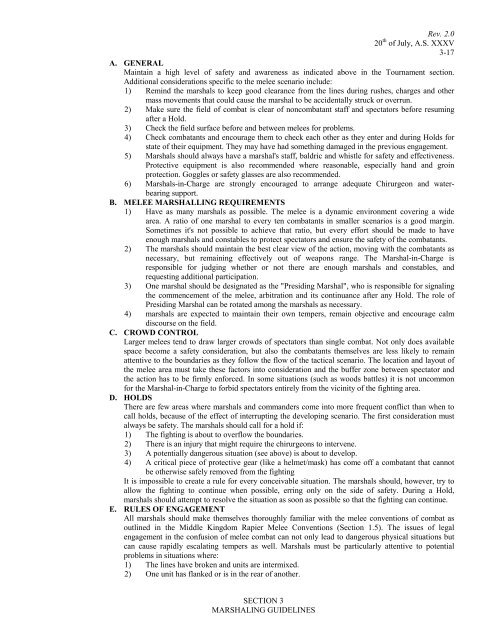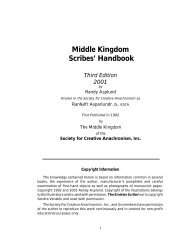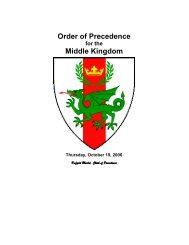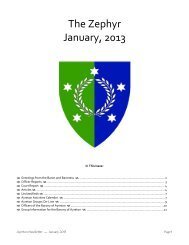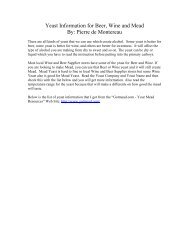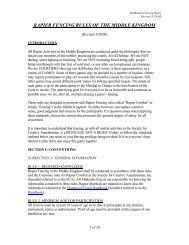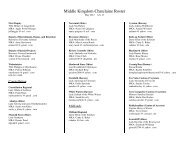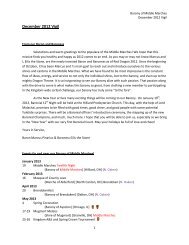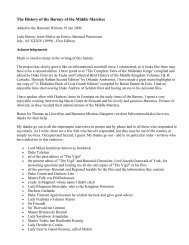Rapier Marshals Handbook - Midrealm / Middle Kingdom
Rapier Marshals Handbook - Midrealm / Middle Kingdom
Rapier Marshals Handbook - Midrealm / Middle Kingdom
You also want an ePaper? Increase the reach of your titles
YUMPU automatically turns print PDFs into web optimized ePapers that Google loves.
Rev. 2.0<br />
20 th of July, A.S. XXXV<br />
3-17<br />
A. GENERAL<br />
Maintain a high level of safety and awareness as indicated above in the Tournament section.<br />
Additional considerations specific to the melee scenario include:<br />
1) Remind the marshals to keep good clearance from the lines during rushes, charges and other<br />
mass movements that could cause the marshal to be accidentally struck or overrun.<br />
2) Make sure the field of combat is clear of noncombatant staff and spectators before resuming<br />
after a Hold.<br />
3) Check the field surface before and between melees for problems.<br />
4) Check combatants and encourage them to check each other as they enter and during Holds for<br />
state of their equipment. They may have had something damaged in the previous engagement.<br />
5) <strong>Marshals</strong> should always have a marshal's staff, baldric and whistle for safety and effectiveness.<br />
Protective equipment is also recommended where reasonable, especially hand and groin<br />
protection. Goggles or safety glasses are also recommended.<br />
6) <strong>Marshals</strong>-in-Charge are strongly encouraged to arrange adequate Chirurgeon and waterbearing<br />
support.<br />
B. MELEE MARSHALLING REQUIREMENTS<br />
1) Have as many marshals as possible. The melee is a dynamic environment covering a wide<br />
area. A ratio of one marshal to every ten combatants in smaller scenarios is a good margin.<br />
Sometimes it's not possible to achieve that ratio, but every effort should be made to have<br />
enough marshals and constables to protect spectators and ensure the safety of the combatants.<br />
2) The marshals should maintain the best clear view of the action, moving with the combatants as<br />
necessary, but remaining effectively out of weapons range. The Marshal-in-Charge is<br />
responsible for judging whether or not there are enough marshals and constables, and<br />
requesting additional participation.<br />
3) One marshal should be designated as the "Presiding Marshal", who is responsible for signaling<br />
the commencement of the melee, arbitration and its continuance after any Hold. The role of<br />
Presiding Marshal can be rotated among the marshals as necessary.<br />
4) marshals are expected to maintain their own tempers, remain objective and encourage calm<br />
discourse on the field.<br />
C. CROWD CONTROL<br />
Larger melees tend to draw larger crowds of spectators than single combat. Not only does available<br />
space become a safety consideration, but also the combatants themselves are less likely to remain<br />
attentive to the boundaries as they follow the flow of the tactical scenario. The location and layout of<br />
the melee area must take these factors into consideration and the buffer zone between spectator and<br />
the action has to be firmly enforced. In some situations (such as woods battles) it is not uncommon<br />
for the Marshal-in-Charge to forbid spectators entirely from the vicinity of the fighting area.<br />
D. HOLDS<br />
There are few areas where marshals and commanders come into more frequent conflict than when to<br />
call holds, because of the effect of interrupting the developing scenario. The first consideration must<br />
always be safety. The marshals should call for a hold if:<br />
1) The fighting is about to overflow the boundaries.<br />
2) There is an injury that might require the chirurgeons to intervene.<br />
3) A potentially dangerous situation (see above) is about to develop.<br />
4) A critical piece of protective gear (like a helmet/mask) has come off a combatant that cannot<br />
be otherwise safely removed from the fighting<br />
It is impossible to create a rule for every conceivable situation. The marshals should, however, try to<br />
allow the fighting to continue when possible, erring only on the side of safety. During a Hold,<br />
marshals should attempt to resolve the situation as soon as possible so that the fighting can continue.<br />
E. RULES OF ENGAGEMENT<br />
All marshals should make themselves thoroughly familiar with the melee conventions of combat as<br />
outlined in the <strong>Middle</strong> <strong>Kingdom</strong> <strong>Rapier</strong> Melee Conventions (Section 1.5). The issues of legal<br />
engagement in the confusion of melee combat can not only lead to dangerous physical situations but<br />
can cause rapidly escalating tempers as well. <strong>Marshals</strong> must be particularly attentive to potential<br />
problems in situations where:<br />
1) The lines have broken and units are intermixed.<br />
2) One unit has flanked or is in the rear of another.<br />
SECTION 3<br />
MARSHALING GUIDELINES


